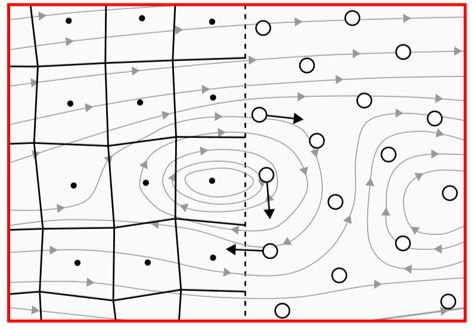Coupling of SPH and FV
The primary atomization of liquid fuel in the combustion chamber of turbomachinery is difficult or impossible to study experimentally due to the high pressures and temperatures involved and the low optical accessibility. For this reason, the ITS uses the particle-based Smoothed Particle Hydrodynamics method (SPH) to analyze this process numerically. Due to its Lagrangian character, this method has inherent advantages in the calculation of multiphase flows with extreme interface deformation compared to classical grid-based finite volume (FV) methods.
However, for applications outside the primary decay region, where the advantages of SPH are negated, there is a large experience and knowledge advantage with these grid methods. The aim of this research area is therefore to develop a method with which SPH and FV can be coupled in order to be able to utilize the advantages of the methods in the respective areas in a calculation.
Challenges
Coupling with other methods is known as one of the 'Grand Challenges' in the SPH community [1]. As a result of earlier work at ITS, a method for coupling SPH and FV was developed, with which simple single-phase test cases can be calculated [2]. The following milestones are based on this:
- Extension to multiphase flows
- Extension to three-dimensional problems with non-planar boundaries
- Implementation in the in-house research code turboSPH
- Application to real problems with reference to atomization
[1] Vacondio, R., Altomare, C., De Leffe, M., Hu, X., Le Touzé, D., Lind, S., ... & Souto-Iglesias, A. (2021). Grand challenges for Smoothed Particle Hydrodynamics numerical schemes. Computational Particle Mechanics, 8, 575-588.
[2] Werdelmann, B., Koch, R., Krebs, W., & Bauer, H. J. (2021). An approach for permeable boundary conditions in SPH. Journal of Computational Physics, 444, 110562.


